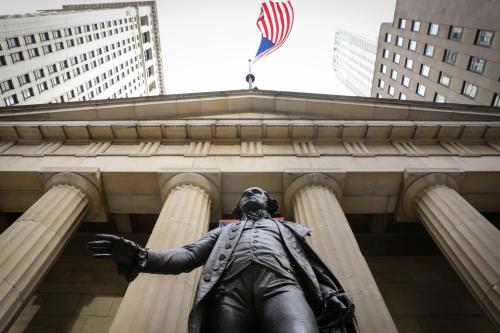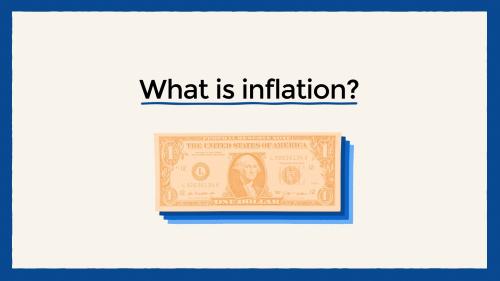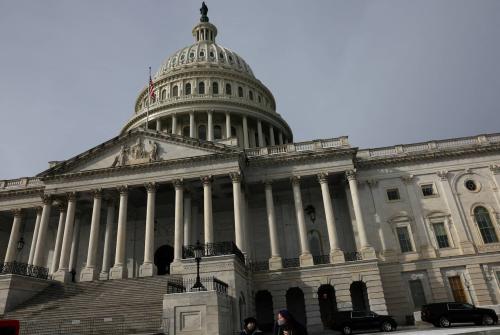With the economy in decline and the deficit rising sharply due to several major coronavirus-related relief bills, a growing chorus of voices is asking how we will pay for the policies that were enacted and arguing that further actions should be curtailed.
But this is not the time to get wobbly. Additional federal relief would produce substantial benefits at low costs. We can learn from history and avoid policymakers’ knee-jerk tendency to cut off stimulus too quickly after a recession. During the Great Depression, in the 1990s in Japan, and in the past decade—in the U.S. but especially in the U.K. and continental Europe— law makers’ premature moves to austerity held back recoveries and, in some cases, created new recessions. The risks of doing too little now far outweigh the risks of doing too much.
To be clear, there is no question that the COVID-19 pandemic has significantly hurt the fiscal outlook. Earlier this year, the Congressional Budget Office (CBO) projected an annual deficit of about $1 trillion for 2020. Now, that figure is set at $3.7 trillion (almost 18 percent of GDP). In contrast, even during the Great Recession, the deficit never exceeded 10 percent of GDP. Before the pandemic, the stock of outstanding public debt was projected to be 81 percent of GDP by the end of the year. Now CBO expects that figure to reach 101 percent this year and 108 percent next year.
This would shatter the previous record, a debt-to-GDP ratio of 106 percent, reached just after World War II. Notably, however, there was no fiscal crisis after the war. Instead, the debt-to-GDP ratio gradually dwindled to 28 percent over the ensuing 35 years, an outcome that contains both good and bad news for the current long-term fiscal shortfall. Between 1945 and 1980, interest rates on government debt were often below the economic growth rate, which helped to reduce the debt-to-GDP ratio. Likewise, interest rates are currently projected to remain below growth rates for the next 30 years. That’s the good news.
The bad news is that, unlike today, the federal government maintained balanced primary budgets (excluding interest payments) on average over the 1945-1980 period. In contrast, recent projections (made before the pandemic) show future primary deficits exceeding 3 percent of GDP on average over the next 30 years. These primary deficits—sufficiently large to cause projected debt to grow steadily and inexorably relative to GDP despite low interest rates—could be even larger after the pandemic’s effects are taken into account. This problem, though, should be addressed after the pandemic has passed and the economy has recovered.
The case for additional actions now is strong. First, the benefits of additional policies would be substantial. For example, funds targeted to state and local governments would help mitigate the recession and retain vital human services. States face balanced budget rules and thus would otherwise have to cut spending as their revenues decline, deepening the downturn.
Second, not all debt is bad. What distinguishes good and bad debt is how it is used. Bad debt is unproductive. Good debt serves genuine national investments. Debt used to finance military efforts in the second World War averted an existential international threat. Likewise, new debt issued today would be fighting an unprecedented world-wide viral pandemic and restarting the economy.
Third, U.S. public debt is not going to trigger a crisis like the one Greece faced in the wake of the 2008 recession. The U.S. borrows in its own currency. We can pay our debts for decades to come. And interest rates as low as ours signal that government bonds remain in demand. Even in 2008, when the U.S. literally exported a financial crisis, the rest of the world responded by sending funds here because we were a safe place to invest.
In fact, the costs of additional actions would be small. Adjusted for projected inflation, interest rates on government debt are negative over most horizons. Indeed, there may not be any net costs at all, once the impact on the economy is accounted for.
The nation needs to address its long-term fiscal shortfalls, which are certainly worse now than they were before the pandemic. But it is also clear that we now face a different problem that dwarfs the federal debt in severity. The only way to achieve a strong long-term budget is to first generate a strong economy. And we can’t fix the economy until the virus is under control. Federal stimulus can help deal with the virus and the economy and thus can strengthen our long-term economic and budget prospects even as it increases the current deficit. Being timid in our policy solutions during this crisis would be a mistake.
I thank Grace Enda and Claire Haldeman for outstanding research assistance.







Commentary
We can afford more stimulus
April 30, 2020